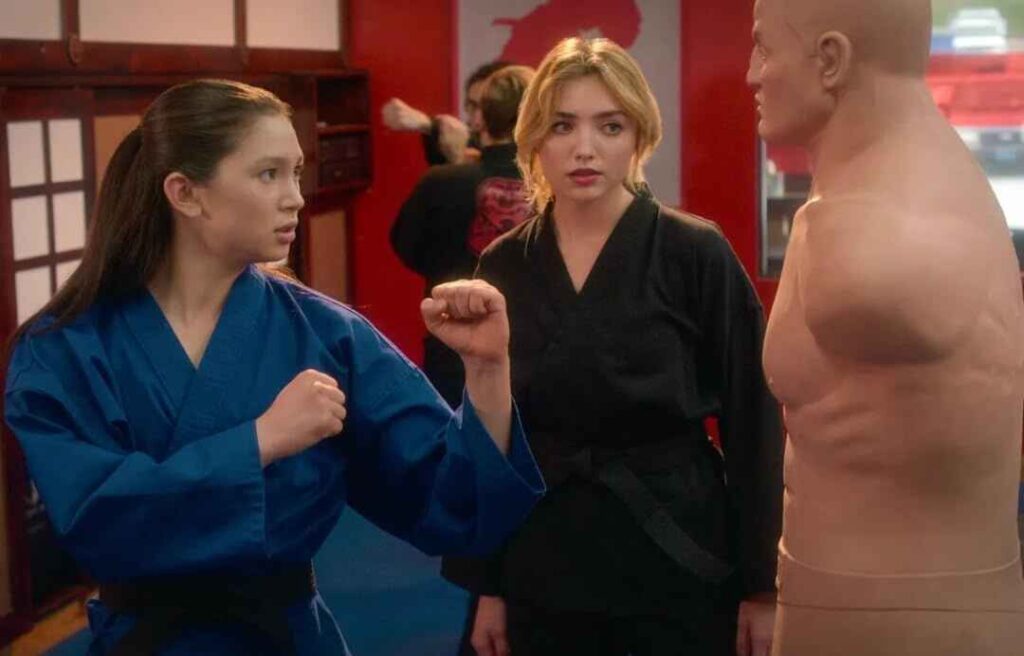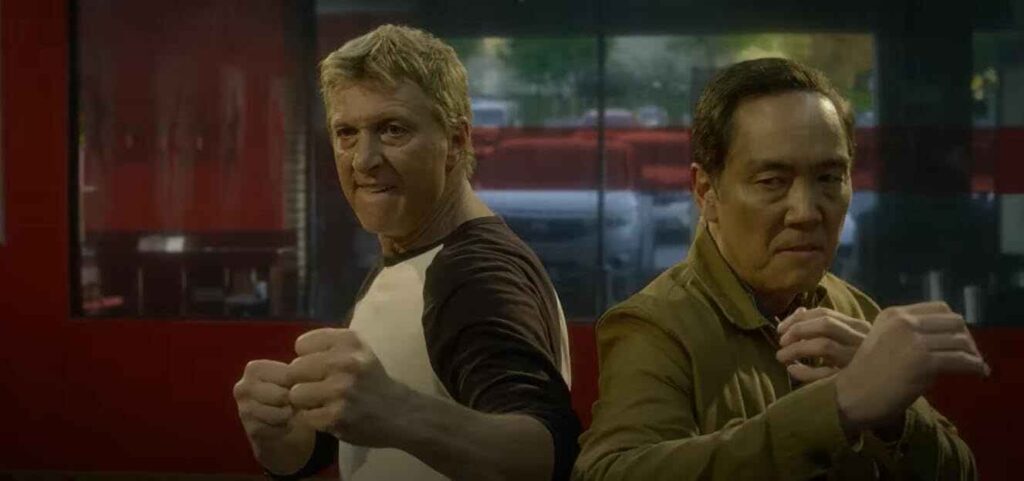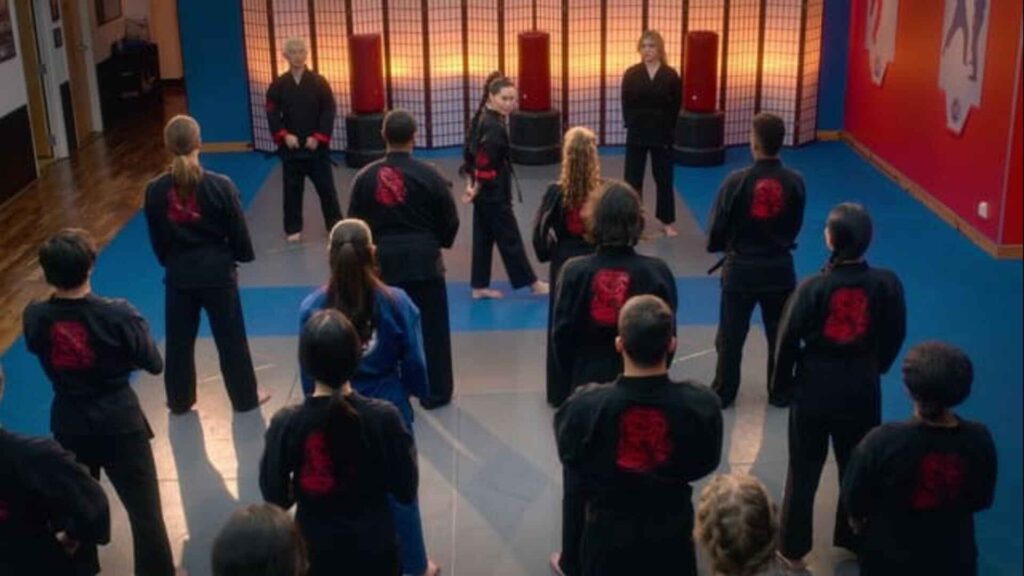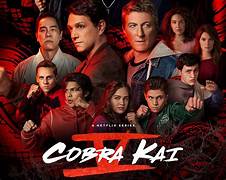Table of Contents
Plot of the Cobra Kai Season 5 Episode 6
Welcome to Cobra Kai Season 5 Episode 6 review. The episode title, “Ouroboros,” references the ancient symbol of a snake eating its own tail, symbolizing the cyclical nature of conflict and rebirth. This aptly reflects the themes explored in the episode, where old wounds resurface, unlikely alliances form, and the characters grapple with the consequences of their choices.
The episode opens with Terry Silver in South Korea, welcoming Kim Da-Eun, a renowned karate sensei. He offers her a partnership, promising half of Cobra Kai if she brings her top students to America. Da-Eun, initially skeptical, is swayed by Silver’s vision of a global Cobra Kai legacy.
Back in California, Johnny tries to connect with Daniel after his recent attack by Silver. However, Daniel, traumatized and disillusioned, declares he’s done with karate. Johnny, frustrated and worried, confides in Chozen, who agrees with Daniel’s need for peace but urges Johnny not to give up.

Cobra Kai’s expansion is evident as Kim Da-Eun and her students arrive at the dojo. Johnny and Chozen witness their ruthless training methods and sense an impending threat. Terry introduces them as his “insurance policy,” sending a clear message of dominance.
Meanwhile, in prison, Kreese faces his own challenges. He is targeted by a bully and his gang, but instead of cowering, he channels his Miyagi-Do training and effortlessly defeats them. This victory earns him respect from the other inmates, who begin to see him as a leader.
Also read: Carousel (1956): A timeless musical classic
Amanda, alarmed by Daniel’s despondency, takes him to Miyagi-Do. There, Robby and Amanda offer words of encouragement, reminding him of his responsibility to protect those he cares about. Daniel, touched by their support, begins to reconsider his stance.
Later, Johnny visits Miyagi-Do and finds Daniel meditating in the garden. They have a heartfelt conversation, acknowledging their past mistakes and recognizing the need to stand together against Cobra Kai. Johnny, inspired by Daniel’s determination, proposes a plan: they will train their students together, combining Miyagi-Do and Eagle Fang techniques to create a new, united front.
The episode culminates in a tense showdown. Kim Da-Eun challenges Johnny and Chozen to a fight, confident in her students’ superiority. Johnny and Chozen, though outnumbered, refuse to back down. Just as the fight is about to begin, Daniel appears, ready to join the fray.
The episode ends with the three senseis standing side-by-side, facing their adversaries. This powerful image symbolizes the rebirth of their alliance, fueled by a newfound sense of purpose and unity. The ouroboros, the symbol of endless cycles, hangs heavy in the air, hinting at the inevitable clashes and triumphs that await them in the coming episodes.
Here are some additional details to consider:
The episode sheds light on Kim Da-Eun’s motivations, revealing her desire to escape the confines of traditional karate and embrace Silver’s vision of a more aggressive style.
We see a glimpse of Kreese’s redemption arc as he uses Miyagi-Do teachings to overcome his inner demons and earn respect in a hostile environment.
The episode emphasizes the importance of family and mentorship, with Amanda and Robby playing crucial roles in Daniel’s journey of self-discovery.
The final scene leaves the audience with a sense of anticipation, eager to see how the combined forces of Miyagi-Do and Eagle Fang will fare against Cobra Kai’s growing power.
Overall, “Ouroboros” is a pivotal episode in Cobra Kai season 5, marking a turning point for the characters and the series as a whole. It is packed with action, emotional moments, and intriguing developments, leaving fans eager for the next chapter in this epic karate saga.
Action and Direction in the Cobra Kai Season 5 Episode 6
“Ouroboros” delivers on the action and excitement that Cobra Kai fans crave, while also showcasing strategic use of camerawork and editing to enhance the emotional impact of the narrative. Here’s a breakdown of the action and direction:

1. Opening Setpiece: Arrival of Kim Da-Eun:
Cinematographer Daniel Wise opts for a wide shot as Silver welcomes Da-Eun, emphasizing the grandeur of the South Korean setting and the imposing presence of her students.
The camera lingers on Da-Eun’s face, capturing her initial skepticism and gradual shift toward acceptance of Silver’s offer.
Also read: The Pope’s Exorcist (2023): Faith Shattered, Evil Unleashed
The editing is crisp and efficient, showcasing the arrival of each student with sharp cuts and close-ups that highlight their athleticism and intimidating skills.
2. Johnny and Chozen React to Cobra Kai’s Expansion:
Handheld camerawork adds a sense of urgency and claustrophobia as Johnny and Chozen observe the Cobras’ training.
Quick cuts between wide shots of the dojo and close-ups of Kim Da-Eun’s commanding presence underscore the scale of Cobra Kai’s threat.
The fight scene between Kyler and Terry’s new Korean student is choreographed in a brutal, no-nonsense style, reflecting the aggressive Cobra Kai philosophy.
3. Kreese’s Redemption Arc in Prison:
The prison fight utilizes slow-motion shots to emphasize Kreese’s precise movements and control.
Tight close-ups on his face reveal a newfound inner strength and confidence.
The editing juxtaposes the brutality of the fight with shots of Kreese meditating later, highlighting his journey toward self-mastery.
4. Daniel’s Emotional Turnaround:
The scene in the Miyagi-Do dojo employs soft lighting and intimate framing to create a safe space for Daniel’s vulnerability.
The editing seamlessly intercuts flashbacks of Mr. Miyagi with Amanda and Robby’s words of encouragement, building towards Daniel’s decision to fight again.
The final shot of Daniel standing in the garden bathed in sunlight symbolizes his renewed hope and determination.
5. The Showdown:
The camera work in the climactic scene builds tension: slow pans over the opposing teams, close-ups on determined faces, and quick cuts between characters emphasize the anticipation and uncertainty.
The choreography combines the graceful fluidity of Miyagi-Do with the aggressive strikes of Eagle Fang, showcasing the potential of their combined strength.
The episode ends with a powerful freeze-frame of the three senseis standing together, ready for battle, leaving a lasting image of their unity against Cobra Kai.
Overall, the action and direction in “Ouroboros” are carefully crafted to serve the story and character development. The camera work, editing, and fight choreography combine to create a thrilling and emotionally engaging experience, leaving viewers on the edge of their seats for the next chapter in this epic karate saga.
Additional Notes:
The episode’s title, “Ouroboros,” is reflected in the camerawork through circular tracking shots and compositions, emphasizing the cyclical nature of conflict and rebirth.
The use of music is also noteworthy, with John Swihart’s score seamlessly blending intense action cues with uplifting and melancholic themes to match the emotional shifts of the narrative.
Character Development in the Cobra Kai Season 5 Episode 6
“Ouroboros” marks a pivotal point in Cobra Kai’s narrative, with several characters experiencing significant growth and transformations. Here’s a closer look at the key character developments:
1. Johnny Lawrence:
From Fearful to Defiant: Initially stunned by Cobra Kai’s expansion, Johnny’s fear is replaced by determination. He embraces Daniel’s suggestion to unite their styles, showing a willingness to adapt and collaborate.

2. Daniel LaRusso:
From Broken to Resolute: Haunted by his near-death experience, Daniel initially retreats from karate. However, Amanda and Robby’s words, coupled with Johnny’s unwavering support, reignite his fighting spirit. He emerges stronger, ready to face Cobra Kai on his own terms.
3. Kreese Silver:
From Manipulator to Teacher: Terry continues his manipulative schemes, recruiting Kim Da-Eun and consolidating his power. However, a glimpse of vulnerability emerges when he confides in his late student Johnny, hinting at a possible shift in his motivations.
4. Kim Da-Eun:
From Skeptical to Ambitious: Initially wary of Silver’s offer, Kim succumbs to the allure of Cobra Kai’s global vision. Her ambition and ruthlessness solidify her as a formidable threat to Miyagi-Do and Eagle Fang.
5. Chozen Toguchi:
From Outsider to Ally: Though still hesitant, Chozen recognizes the urgency of the situation and aligns himself with Johnny and Daniel. His presence signifies a willingness to bridge the gap between their rivalries.
6. Amanda LaRusso:
From Supportive Wife to Proactive Guardian: Amanda acts as Daniel’s emotional anchor, reminding him of his strengths and responsibilities. She actively encourages him to fight back, demonstrating her crucial role in their family unit.
7. Robby Keene:
From Anguished Son to Mentor: Robby offers Daniel sage advice, urging him to reclaim his passion for karate. This gesture signifies a possible reconciliation and Robby’s evolving perspective on his former sensei.
8. Miguel Diaz:
From Cobra Kai Prodigy to Uncertain Observer: Miguel witnesses Terry’s ruthless tactics and Kim Da-Eun’s arrival with unease. His internal conflict foreshadows a potential rift within Cobra Kai and a possible shift in Miguel’s loyalties.
“Ouroboros” lays the groundwork for future character arcs, setting the stage for alliances, betrayals, and potentially, redemption. The episode expertly weaves character development within its narrative, reminding us that despite the karate and Cobra Kai’s power struggles, it’s the characters and their journeys that truly captivate the audience.
Visual Effects and Cinematography in the Cobra Kai Season 5 Episode 6
While Cobra Kai generally relies on practical stunts and choreography rather than heavy visual effects, “Ouroboros” does utilize some subtle yet impactful visual elements alongside its strong cinematography. Let’s delve into the details:
Cinematography:
Wide & Close-Up Shots: Cinematographer Daniel Wise masterfully employs contrasting shot sizes to enhance the episode’s emotional impact. Wide shots establish the grandeur of Da-Eun’s arrival and the oppressive atmosphere of Cobra Kai training, while close-ups heighten character vulnerability in scenes like Daniel’s contemplation and Johnny’s confrontation with Silver.

Handheld Camerawork: Handheld shots inject a sense of raw energy and immediacy into fight scenes, particularly Kreese’s prison brawl and the showdown. This technique immerses viewers in the chaos and intensity of the action.
Slow-Motion and Freeze-Frames: Wisely used slow-motion emphasizes the precision and brutality of fight moves, especially during Kreese’s fight. The final freeze-frame on the United senseis stands as a powerful image, solidifying their alliance and setting the stage for future clashes.
Visual Effects:
Minimal but Impactful: “Ouroboros” features minimal visual effects, primarily focused on enhancing fight sequences and establishing certain locations. For example, subtle wirework might be used to amplify acrobatic jumps or kicks, while CGI might extend training areas or add environmental details to South Korea.
Symbolic Imagery: The recurring ouroboros motif is subtly incorporated through circular tracking shots, and camera movements that mimic the snake eating its tail. This visually reinforces the episode’s theme of cyclical conflict and rebirth.
Lighting and Color:
Contrasting Palettes: The episode utilizes distinct lighting and color palettes to differentiate locations and moods. The South Korean scenes boast bright, vibrant colors, reflecting Da-Eun’s confident personality and ambitious vision. In contrast, Miyagi-Do scenes embrace warmer, softer tones, symbolizing Daniel’s emotional journey and inner peace. Cobra Kai, on the other hand, is bathed in cold, steely hues, reflecting their aggressive philosophy and dominance.
Symbolic Use of Light: Daniel’s scene in the Miyagi-Do garden is bathed in sunlight, signifying his renewed hope and determination. Similarly, the final shot of the united senseis standing together is well-lit, hinting at their potential victory against Cobra Kai’s darkness.
“Ouroboros” demonstrates how subtle visual effects and cinematography can elevate a narrative without overshadowing the story or characters. The choices made in shot composition, camera movement, lighting, and color palettes effectively enhance the emotional impact of the episode, leaving a lasting impression on viewers.
World-Building in the Cobra Kai Season 5 Episode 6
In “Ouroboros,” Cobra Kai’s world expands beyond the familiar karate dojos of California, injecting fresh dynamism and complexity into the narrative. Here’s a breakdown of the episode’s world-building elements:
1. Expanding Cobra Kai’s Reach:
Kim Da-Eun’s Arrival: The introduction of Kim Da-Eun and her team of elite Korean students signifies Cobra Kai’s global ambitions. This expands the dojo’s reach beyond its local rivalry with Miyagi-Do, hinting at potential international conflicts and alliances.
Silver’s Masterplan: Terry Silver’s vision of a global Cobra Kai empire becomes palpable. His strategic partnerships and aggressive expansion raise the stakes, creating a larger world for the characters to navigate.
2. Contrasting Philosophies:
Clash of Styles: Kim Da-Eun’s ruthless, hyper-aggressive fighting style, rooted in Taekwondo, stands in stark contrast to Miyagi-Do’s emphasis on balance and defense. This clash showcases the diversity of karate philosophies within the Cobra Kai universe.
Miyagi-Do’s Evolution: Daniel’s decision to merge Miyagi-Do and Eagle Fang styles signifies an adaptation to the evolving karate landscape. This creates a new world within the dojo, one that blends tradition with innovation.
3. The Prison as a Microcosm:
Kreese’s Leadership: Kreese’s rise to power within the prison environment creates a microcosm of Cobra Kai’s dominance. This further emphasizes the dojo’s philosophy and its potential impact on individuals and communities.
Challenges and Redemption: The prison also serves as a crucible for Kreese’s potential redemption. His use of Miyagi-Do teachings to overcome adversity hints at a possible shift in his character development and its consequences on the larger Cobra Kai world.
4. Hidden Connections:
Terry Silver’s Past: Silver’s connection to Kim Da-Eun and their shared history add depth and intrigue to the Cobra Kai universe. This reveals hidden alliances and motivations, hinting at future power struggles and betrayals.
Ouroboros Symbolism: The recurring ouroboros symbol, representing cycles of conflict and rebirth, subtly reinforces the interconnectedness of the characters and their fates. This world-building element adds a layer of thematic depth to the narrative.
“Ouroboros” masterfully expands the Cobra Kai universe by introducing new characters, locations, and conflicts. The episode paints a picture of a world beyond the Karate Kid legacy, one where karate transcends local rivalries and embraces a global stage. This intricate world-building adds depth and intrigue to the narrative, leaving viewers eager to see how the characters navigate its ever-evolving landscape.
Music and Sound Design in the Cobra Kai Season 5 Episode 6
The music and sound design in “Ouroboros” play a crucial role in heightening the episode’s emotional impact and immersing viewers in the action. Here’s a detailed breakdown:
1. John Swihart’s Score:
Emotional Undercurrents: Composer John Swihart masterfully employs a blend of orchestral and electronic elements to create a dynamic score that reflects the shifting emotions of the characters and the narrative. Uplifting melodies intertwine with melancholic piano chords during Daniel’s introspective moments, while intense, percussive rhythms build anticipation during fight scenes.
Themes and Motifs: Swihart utilizes recurring themes and motifs to connect characters and reinforce thematic elements. The iconic Miyagi-Do theme poignantly underscores Daniel’s struggle and eventual determination, while Cobra Kai’s aggressive motif ominously foreshadows their expanding power.
2. Sound Design:
Immersive Atmosphere: The sound design team meticulously crafts soundscapes that transport viewers into the episode’s various settings. The bustling streets of South Korea, the echoing halls of the prison, and the tense silence of the Miyagi-Do garden are all brought to life through distinct environmental sounds.
Fight Choreography Enhancement: Punches, kicks, and blocks are accentuated with sharp sound effects that heighten the impact and brutality of the fight scenes. This adds to the realism and intensity of the action, keeping viewers on the edge of their seats.
3. Song Choices:
Symbolic Cues: Carefully chosen licensed tracks enhance specific scenes and add an extra layer of meaning. For example, a montage of Cobra Kai’s training might be underscored by a song with lyrics reflecting power and dominance, while a scene of introspection might feature a more introspective and melancholic track.
4. Silence as a Storytelling Tool:
Heightened Tension: The episode effectively utilizes moments of silence to build tension and anticipation. The absence of music during key confrontations allows the weight of the character’s words and actions to resonate deeply with viewers.
Emotional Impact: Certain scenes, like Daniel’s contemplation in the garden or Johnny’s heartfelt conversation with Chozen, rely heavily on silence to evoke poignant emotions and allow viewers to connect with the characters on a deeper level.
The music and sound design in “Ouroboros” are not mere background elements; they are integral to the storytelling, weaving seamlessly with the visuals and performances to create a truly immersive and impactful experience. Swihart’s score provides emotional depth and thematic resonance, while the sound design and song choices add realism and nuance to the narrative. Through its masterful use of music and sound, “Ouroboros” delivers a powerful and unforgettable episode that will stay with viewers long after the credits roll.
The pacing and episode structure in the Cobra Kai Season 5 Episode 6
“Ouroboros” masterfully utilizes pacing and episode structure to keep viewers engaged and anticipating the next twist. Here’s a breakdown of its key elements:
1. Deliberate Pacing:
Balanced Action and Emotion: The episode seamlessly blends action-packed fight scenes with introspective character moments. This deliberate pacing allows viewers to savor the emotional journeys of the characters while also enjoying the thrill of the karate action.
Building Anticipation: Key confrontations and plot developments are strategically placed throughout the episode. The pacing slows down during crucial conversations and fight preparations, building anticipation before erupting into moments of high tension and action.
2. A-Plot and B-Plot Convergence:
Intertwined Stories: The episode effectively juggles two main storylines: Cobra Kai’s expansion with Kim Da-Eun’s arrival and Daniel’s emotional battle and eventual return to karate. Both plots remain compelling on their own, but they ultimately converge in the powerful final scene, where the heroes unite against a common enemy.
Parallel Character Arcs: Certain characters mirror each other’s journeys, adding richness to the narrative. Johnny and Daniel, despite their initial differences, both overcome fear and doubt to embrace their fighting spirit. Similarly, Kreese and Kim Da-Eun, both with a history of seeking power, showcase different approaches to leadership and its consequences.
3. Cliffhanger Ending:
Open Questions and Future Conflicts: The episode concludes with a strong cliffhanger, leaving viewers eager for the next chapter. The united senseis facing Cobra Kai raises several questions: Will their alliance hold? How will Kim Da-Eun react to Cobra Kai’s internal conflict? This keeps viewers actively engaged and speculating about the future of the narrative.
4. Circular Structure:
Ouroboros Symbolism: The episode subtly reflects the ouroboros symbol through its structure. The opening scene introduces Cobra Kai’s expanding power, followed by Daniel’s internal struggle and eventual rebirth as a fighter. The episode then circles back to Cobra Kai’s dominance before concluding with the united heroes ready to challenge the snake’s grip. This circular structure reinforces the episode’s thematic focus on cyclical conflict and rebirth.
Overall, the pacing and episode structure of “Ouroboros” are carefully crafted to maximize engagement and suspense. The balanced action and emotion, interwoven plotlines, and cliffhanger ending keep viewers glued to the screen, while the circular structure and thematic undercurrents add depth and intrigue to the narrative. This episode exemplifies how pacing and structure can elevate a story, leaving a lasting impression on viewers and setting the stage for the exciting developments to come in Cobra Kai season 5.
overall enjoyment and recommendation of the Cobra Kai Season 5 Episode 6
“Ouroboros” is widely considered a standout episode in Cobra Kai season 5, earning praise for its action, character development, world-building, and overall emotional impact. Here’s a breakdown of its overall enjoyment and recommendation:
Reasons to enjoy:
Thrilling Action and Fight Choreography: The episode delivers action sequences that are both brutal and visually stunning. Kim Da-Eun’s introduction fight and the final showdown are highlights, showcasing impressive choreography and heightened tension.
Compelling Character Arcs: Each character experiences significant growth and internal conflict, keeping viewers invested in their individual journeys. Daniel’s emotional struggle and eventual return to karate forms the emotional core of the episode, while Johnny, Kreese, and Kim Da-Eun all grapple with their own demons and ambitions.
Intriguing World-Building: The episode expands the Cobra Kai universe by introducing new characters, locations, and conflicts. Kim Da-Eun’s arrival signifies Cobra Kai’s global ambitions, while Kreese’s experiences in prison offer another glimpse into the dojo’s dark side.
Masterful Pacing and Structure: The episode expertly balances action and emotion, keeps viewers engaged through interwoven plotlines, and culminates in a powerful cliffhanger ending. The circular structure and ouroboros symbolism add thematic depth and intrigue.
Emotional Resonance: The episode’s exploration of themes like fear, doubt, redemption, and unity resonates with viewers on a personal level. Daniel’s struggle to overcome his trauma and Johnny’s unwavering support evoke genuine emotions, further solidifying the series’ connection with its audience.
Recommendation:
Highly Recommended: Whether you’re a seasoned Cobra Kai fan or a newcomer to the series, “Ouroboros” is a must-watch episode. It offers everything fans love about the series: intense action, engaging characters, emotional stakes, and a compelling narrative.
Great Entry Point for New Viewers: This episode acts as a microcosm of the series’ strengths, showcasing its blend of humor, drama, and martial arts action. Newcomers can easily jump in and grasp the main conflicts and dynamics, making it a perfect entry point to the Cobra Kai universe.
Overall, “Ouroboros” is a thrilling, emotional, and thought-provoking episode that captures the essence of what makes Cobra Kai so captivating. It delivers on all fronts, exceeding expectations and leaving viewers eager for the next chapter in this karate saga.
Disclaimer: While the majority of viewers enjoyed “Ouroboros,” it’s important to acknowledge that personal preferences vary. Some viewers might find the episode’s focus on action over comedy to be a slight departure from previous seasons. However, the overall consensus remains overwhelmingly positive, highlighting the episode’s strong execution and impactful storytelling.
